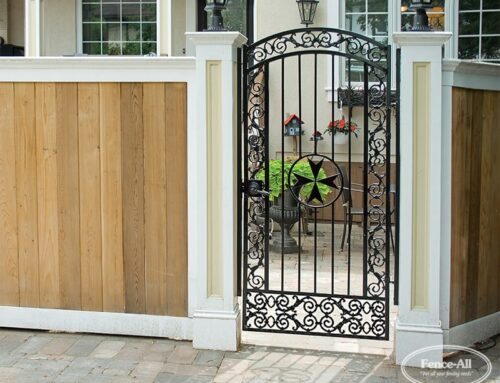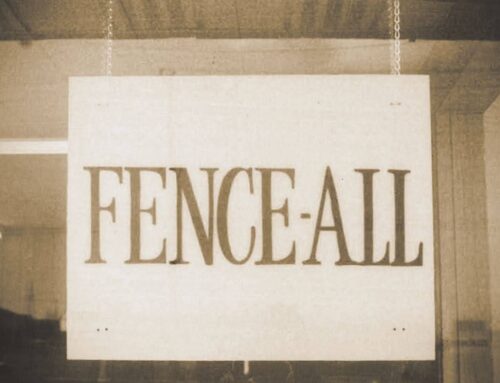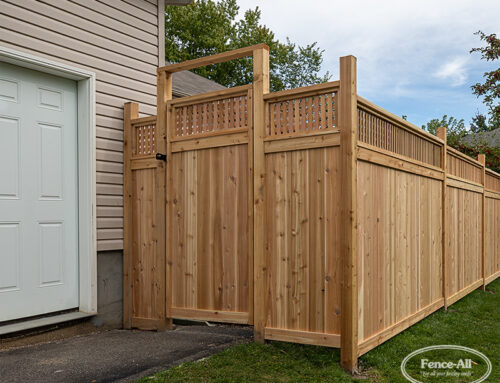The last thing you want is to protect your property with a beautiful fence, only to find out it’s too tall and needs to be removed or cut/trimmed. Now, to be completely transparent, that has never happened to a Fence All customer before. We pride ourselves in taking care of your needs every step of the way. However, if you’re a DIYer, or just starting to plan your fence, we wanted to help by offering this guide to how tall your fence should be. Please keep in mind that we are addressing bylaws and standards in the City of Ottawa.
HOW TO CALCULATE THE HEIGHT
Thankfully, the City of Ottawa provides some additional insight into how their inspectors measure the height of a fence. An inspector will always begin his/her measurement “from the grade at the base of the fence.” (The information provided in quotes is specifically taken from the city’s website here).
However, there are two possible heights that can be considered:
1. The inspector will measure to the “top of the fence where erected at grade and where there is no difference between the two sides of the fence”. Or
2. “From the higher grade to the top of the fence where erected at grade and there is a grade difference between the two sides of the fence”.
FENCING RESIDENTIAL PROPERTY
A fence needs to be lower in the front yard than it does in the backyard. This provides visibility for drivers going by out front but allows privacy for you and your family outback.
– OUTFRONT a fence can only be one meter tall.
– OUTBACK a fence can be up to 213cm tall. If you use decorative caps on top of structural posts, they can’t be more than 15cm tall.
– TRANSITIONALS such as a gate must be less than 244 cm tall, while archways should not exceed 250 cm.
VISIBILITY TRIANGLES
You may have noticed in many residential areas, that corner lots aren’t fenced as close to the road as (what looks like) they could be. That’s because we need to keep the line of sight open for drivers. To do so, no fence taller than 75 cm can be erected within three meters of the lot lines on major roads or highways.
POOLS AND HOTTUBS
An enclosure around pools and hot tubs are required, protecting kids from accidents. That means pool fences should be at least 1.5 m tall, but no more than 213cm tall. An enclosure around your pool also needs to be at least one metre from the “nearest inside wetted surface of a pool wall”.
Despite their height, hedges or bushes are not considered acceptable enclosures around a pool. You also want to be sure there’s no attachments to the fence that can facilitate climbing. Barbed wire is not permitted, and the enclosure must not be used as a conductor of electricity.
Fence all offers a special, tighter spaced chain link mesh for pool and hot-tubs, which the city requires. You can choose between five or six feet tall (152cm or 183cm) and have five colours to choose from
ADDITIONAL REQUESTS FROM THE CITY OF OTTAWA
We tend to think that a good fence should harbour three qualities: (1) safe (2) attractive (3) sturdy/durable. While there may be other priorities for you as well; such as privacy, budget-friendly, or eco-friendly. Those first three are also required by the City of Ottawa.
The same bylaw guide also note that each fence must be:
– Stable.
– Vertical.
– Made of high-quality materials.
– Suitable for its purpose.
– In a state of good repair.
– Free of graffiti.
– Protected by paint, preservatives, or other weather-resistant material (with the exception of cedar, redwood or treated wood fences).
Such strict guidelines help to keep our neighbourhoods safe and beautiful. To ensure you’re staying within them, work with a professional team that you can trust. Since stability, durability, and high-quality materials are required year after year, your fence and it’s installation should come with a warranty, as well as a team that can back it up.









